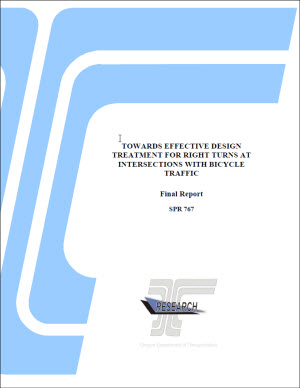 The Oregon Department of Transportation has released a report quantifying the safety performance of alternative traffic controls and design strategies to mitigate right-turning vehicle-bicycle crashes at signalized intersections in Oregon.
The Oregon Department of Transportation has released a report quantifying the safety performance of alternative traffic controls and design strategies to mitigate right-turning vehicle-bicycle crashes at signalized intersections in Oregon.
The document includes design guidance to potentially mitigate such collisions and includes a comprehensive review of past research relating to bicycle and motor vehicle crashes. It identified and analyzed 504 state-wide right-hook crashes between 2007-2011 to determine whether frequency and severity depended on intersection lane configuration and traffic control.
An experiment was developed to investigate causal factors of right-hook crashes at signalized intersections with a striped bike lane and no right-turn lane, and to identify and evaluate alternative design treatments that could mitigate these crashes' occurrence.
First, after extensive simulations, it was determined that the worst-case right-hook scenario occurred when a bicycle was approaching the intersection at 16 mph or greater while in the motorists' blind zone. In crash and near crash situations, the most common cause was drivers' failure to search for an adjacent bicyclist. Also, crashes and near-crashes resulted from motorists incorrectly assuming that the bicycle would yield or that there was enough time to turn in front of the cyclist.
Elements of driver performance and gap acceptance collected in the simulator experiment were then field-validated to further cement the findings. The research collected and reviewed 144 hours of video and identified 43 conflicts where the time-to-collision (TTC) measured less than 5 seconds. The field observations, when isolated, showed that the distribution of simulated TTC values were consistent with those observed in the field.
A second experiment evaluated several possible design treatments, including signage, pavement markings, curb radii, and protected intersection designs and how these treatments effected the visual attention of motorist, their crash avoidance behavior, and the severity of observed crashes.
Overall, the analysis suggest that while all treatments had some positive effect on driver performance, their connection to and their relative effects on crash outcomes is not clear. Additional work is recommended to address the study's limitations and to further consider the potential effects of the right-hook crash mitigation strategies from this research